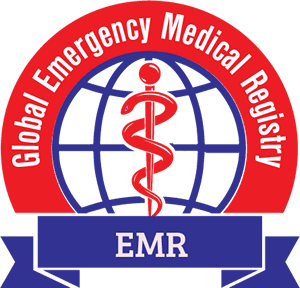What is an EMR?
Emergency Medical Responders (EMR) provide immediate lifesaving care to patients who access the emergency services system. EMRs have the knowledge and skills necessary to provide basic lifesaving interventions while awaiting additional higher level EMS resource arrival. EMRs also provide assistance to higher-level personnel at the scene of emergencies and during transport. Emergency Medical Responders are a vital part of the comprehensive EMS response. Under medical oversight, Emergency Medical Responders perform basic care interventions with minimal equipment.
What is the Scope of Practice of an EMR?
An Emergency Medical Responder may perform the following procedures only when the Emergency Medical Responder is part of an agency which has a Committee approved Medical Director who has issued written standing orders to that Emergency Medical Responder authorizing the following:
- Conduct primary and secondary patient examinations;
- Take and record vital signs;
- Utilize noninvasive diagnostic devices in accordance with manufacturer’s recommendation;
- Open and maintain an airway by positioning the patient’s head;
- Provide external cardiopulmonary resuscitation and obstructed airway care for infants, children, and adults;
- Provide immobilization care for musculoskeletal injuries;
- Assist with prehospital childbirth; and
- Complete a clear and accurate prehospital emergency care report form on all patient contacts and provide a copy of that report to the senior emergency medical services provider with the transporting ambulance.
- Administer medical oxygen;
- Maintain an open airway through the use of:
- A nasopharyngeal airway device;
- A noncuffed oropharyngeal airway device;
- A pharyngeal suctioning device;
- Operate a bag mask ventilation device with reservoir;
- Provide care for suspected medical emergencies, including administering liquid oral glucose for hypoglycemia;
- Prepare and administer aspirin by mouth for suspected myocardial infarction (MI) in patients with no known history of allergy to aspirin or recent gastrointestinal bleed;
- Prepare and administer epinephrine by automatic injection device for anaphylaxis; and
- Perform cardiac defibrillation with an automatic or semi-automatic defibrillator, only when the Emergency Medical Responder
Responsibilities of Registry Certified Personnel:
Certified personnel must notify the Registry within 30 days regarding the following matters:
- Change in mailing address (the best way to update a mailing address is by editing your account profile)
- Any criminal conviction.
- Disciplinary action taken by any agency having jurisdiction (or government body) that has resulted in suspension, revocation, or expiration of registration/licensure; termination of right to practice; voluntary surrender of registration/licensure while under investigation.
The Registry considers the individual to be solely responsible for their certification and reporting, any failure to follow process or report as required is solely the failure of the certified person and may result in immediate dismissal of their certification, as well as, immediate notification to any pertinent regulatory agency of their dismissal.
Disciplinary Policy and Rights of Appeal for The Registry can be found on The Registry website.
Requirements for Initial Registration (Certification):
Individuals applying for EMR certification must meet the following requirements:
- Candidate must be 16 years of age or older
- Successful completion of a registry accredited Emergency Medical Responder (EMR) course that meets or exceeds the Registry Education Standards for the Emergency Medical Responder.
- Candidate must have completed the course within the past two years and the course Program Director must verify successful course completion on the Registry website.
- Candidate must have a current American Heart Association BLS for "Healthcare Provider" or equivalent credential.
- Candidate must successfully complete the Registry cognitive (knowledge) and approved psychomotor (skills) exams. Passed portions of each examination (cognitive and psychomotor) remain valid for 12 months.
Application Process
- Create an account on the Registry website.
- Submit a Registry application and answer all questions truthfully.
- The Registry may deny certification or take other appropriate actions in regards to applicants for certification or recertification when a criminal conviction has occurred.
- Pay the application fee of $40 usd.
- The application fee is non-transferable and non-refundable.
- This fee is charged for each attempt at the cognitive examination.
- Candidates will receive an electronic Authorization to Test (ATT) once you are eligible for the exam.
- The electronic ATT contains scheduling instructions and important details concerning proper identification required at testing centers.
- You can find the ATT in the “Alerts” section of your account page.
- The ATT is your test key and you will need to carry it with you to a testing center to be provided access to your examination.
Reciprocity:
- The candidate who holds a current certification with the National Registry of Emergency Medical Technicians (NREMT), at this level or higher, may apply for reciprocity at this level, if their initial or CME training meets the scope of practice listed above.
- The candidate who holds a current license with a State in the United States, at this level or higher, may apply for reciprocity at this level, if their initial or CME training meets the scope of practice listed above.
- The candidate who holds a current registration with the Paramedicine Board of Australia (PBA), at this level or higher, may apply for reciprocity at this level, if their initial or CME training meets the scope of practice listed above.
- The candidate who holds a current certification with the Pre-Hospital Emergency Care Council (PHECC), at this level or higher, may apply for reciprocity at this level, if their documented training meets the scope of practice listed above.
- The candidate who holds a current certification with the Health & Care Professionals Council (HCPC), at this level or higher, may apply for reciprocity at this level, if their documented training meets the scope of practice listed above.

